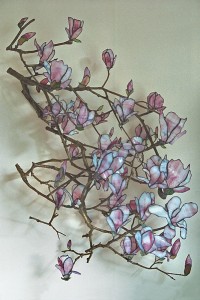Statement
| Robert Oddy Stained Glass Artist: Artistic Methods and Aims |
The living world provides an endless variety of good subjects for stained glass windows, as it has for art in all media from the earliest times. The work that you can view on these pages brings vivid and yet subtle and intricate images of living forms into people’s living and working spaces.
 A distinctive quality of my work is a feeling of depth in the representation of natural subjects, whilst retaining recognizable traits of traditional stained glass art. In my stained glass windows and panels, this impression of depth is largely an illusion created by multiple layers of glass and careful use of color and texture. In some work, however, there is a real sculptural element. I have combined glass with other materials, such as carved wood and cast bronze. “Serpent”, for instance, is a
A distinctive quality of my work is a feeling of depth in the representation of natural subjects, whilst retaining recognizable traits of traditional stained glass art. In my stained glass windows and panels, this impression of depth is largely an illusion created by multiple layers of glass and careful use of color and texture. In some work, however, there is a real sculptural element. I have combined glass with other materials, such as carved wood and cast bronze. “Serpent”, for instance, is a  window in which wood and natural tree bark are incorporated into the design. “Cranes in
window in which wood and natural tree bark are incorporated into the design. “Cranes in Durham”, is a glass panel supported in a free-standing wood carving. It can be placed on a window sill or in front of an artificial light source. I explored the sculptural possibilities of stained glass in the composition “Magnolia #2.” This is not a flat panel at all, but rather an open, three-dimensional sculpture in glass and bronze.
Durham”, is a glass panel supported in a free-standing wood carving. It can be placed on a window sill or in front of an artificial light source. I explored the sculptural possibilities of stained glass in the composition “Magnolia #2.” This is not a flat panel at all, but rather an open, three-dimensional sculpture in glass and bronze.
The richness and beauty in the light, texture, and color of stained glass make it a wonderfully satisfying medium in which to work. I think of my methods as a little like painting. We never perceive the leaves of even a single plant as uniformly green. So, while I work, I have a large variety of glass spread out around me like a palette. By choosing each piece carefully and using multiple layers, I can get artful variations of shade and hue. Transparency is a stylistic theme that I occasionally  explore. Stained glass is a particularly appropriate medium for this. In “Rhododendron” and “Hibiscus”, the effect is of a lightly colored, not-quite-finished sketch.
explore. Stained glass is a particularly appropriate medium for this. In “Rhododendron” and “Hibiscus”, the effect is of a lightly colored, not-quite-finished sketch.
 My design techniques vary, depending on the nature of the project. In some cases, for instance “Lincoln Rose”, “Radiolarian”, and “Hibiscus”, I make a detailed and accurate drawing, because the geometry must be exactly right for the window to be effective. In many cases, however, the working drawing is an outline, and I figure out the detail as the window is actually fabricated. This is particularly true of complex floral arrangements, such as “Roses”.
My design techniques vary, depending on the nature of the project. In some cases, for instance “Lincoln Rose”, “Radiolarian”, and “Hibiscus”, I make a detailed and accurate drawing, because the geometry must be exactly right for the window to be effective. In many cases, however, the working drawing is an outline, and I figure out the detail as the window is actually fabricated. This is particularly true of complex floral arrangements, such as “Roses”.
When designing I try to disregard the usual constraints of the medium (the  existence of lead lines, curves that are convenient for cutting, the two-dimensional format) and just sketch the picture I have in mind. I then call on a range of techniques, often experimenting to achieve the effects I want. I have expanded a little on my aims and techniques in magazine articles Thoughts of an Artist in Stained Glass, The Anatomy of a Commission, and A Stained Glass Artist’s Adventure into Sculpture. I also contributed a series of “how-to” articles to the magazine Glass Patterns Quarterly, which use some of my smaller pieces to explain my methods in detail.
existence of lead lines, curves that are convenient for cutting, the two-dimensional format) and just sketch the picture I have in mind. I then call on a range of techniques, often experimenting to achieve the effects I want. I have expanded a little on my aims and techniques in magazine articles Thoughts of an Artist in Stained Glass, The Anatomy of a Commission, and A Stained Glass Artist’s Adventure into Sculpture. I also contributed a series of “how-to” articles to the magazine Glass Patterns Quarterly, which use some of my smaller pieces to explain my methods in detail.
Most of my work is in private dwellings. Each commission is an original design, which takes into account the wishes and ideas of the individual client and the nature of the site. Thus, you can see quite a range of styles and atmosphere in the stained glass windows on these pages.
web: www.robertoddy.com | mail: [email protected] | phone: (315) 200-2260
